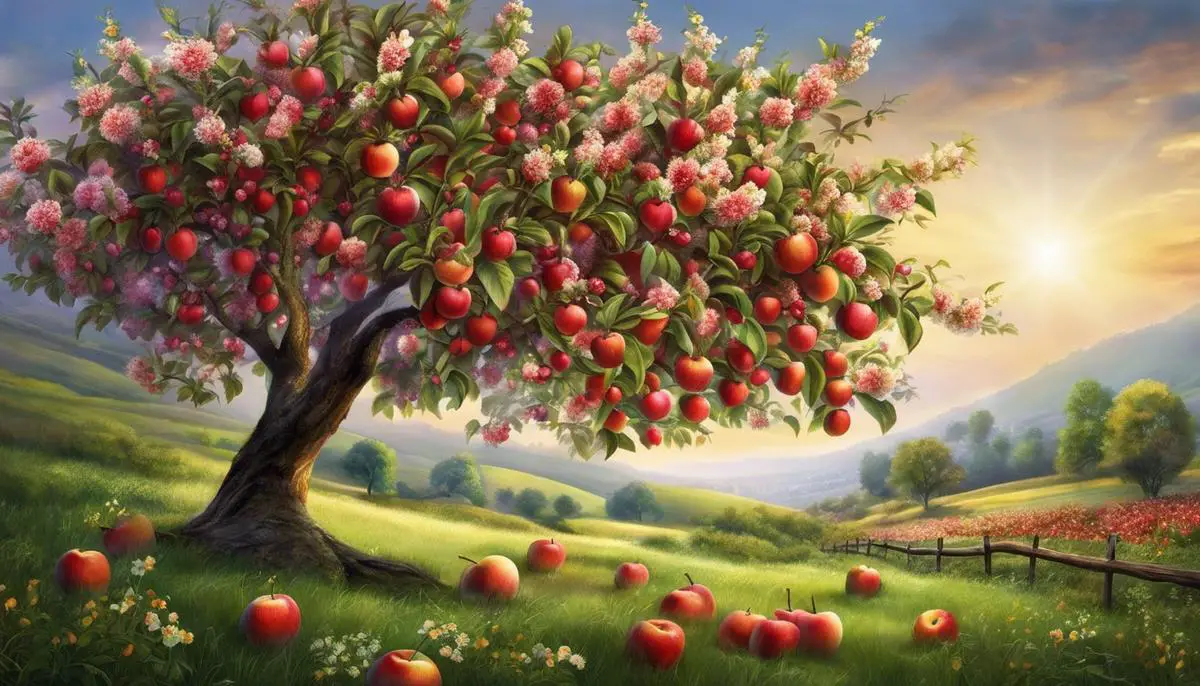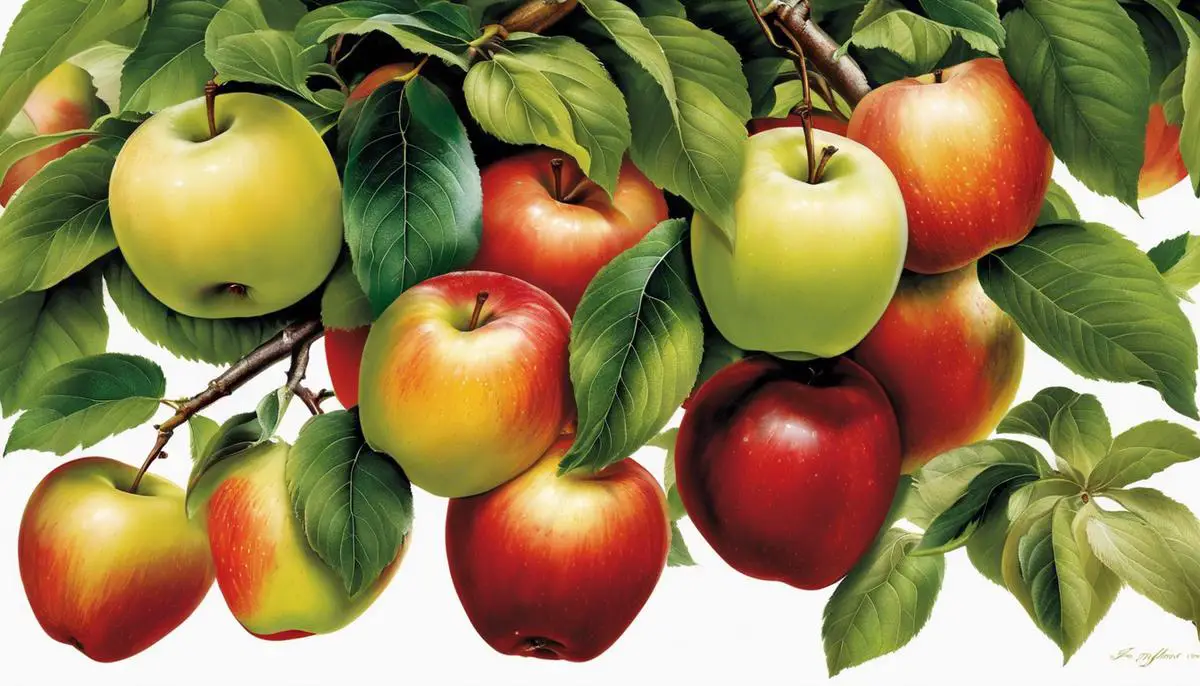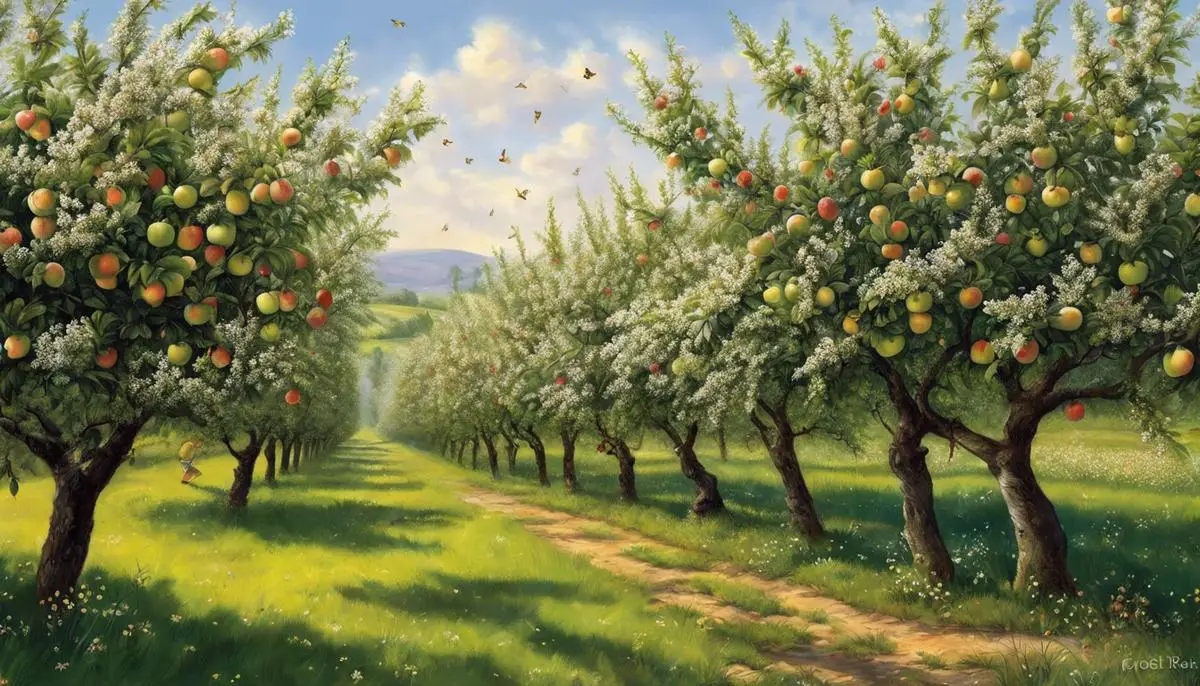Apple trees fall among the most iconic symbols of nature’s bounty, known for their vibrant spring blossoms and the crunchy, juicy fruit they bear. This spectrum of diversity, flavor, and aesthetic appeal would not be possible without a complex process behind the scenes; a process enshrouded by the miracle of pollination. Interestingly, while most apple varieties require cross-pollination, a subset exists that can perform self-pollination, an intriguing phenomenon that merits further exploration. This discourse delves into the intricate mechanism of self-pollination in apple trees, the typologies of these self-fertile varieties, and the respective advantages and disadvantages that this fascinating reproductive strategy entails.
The Mechanism of Self-Pollination in Apple Trees
The Peculiar Puzzle of Apple Tree Self-Pollination: A Dance of Nature Unraveled
For many, the humble apple is a symbol of nature’s bounty, but few pause to appreciate the intricacies that nature deploys to paint the fruits onto the canvas of apple trees. One astounding natural phenomenon unfolds quietly within the confines of these trees—the process of self-pollination. This process, far from a mere curiosity, gears the intricate machinery of apple proliferation.
Understanding self-pollination first requires a grasp on pollination itself. Dominating the natural course of plant propagation, pollination involves transferring pollen, the plant’s male reproductive units, to its female counterpart, the stigma. A fertile union transpires, leading embryonic seeds to form within the fruit—seeds which one day mature into adult trees to continue the cycle.
In many plants, such an exchange relies heavily on external agents like wind or insects. This begets genetic diversity, as pollen from one plant fertilizes another. However, some plants, including several apple tree varieties, are capable of an independent, self-reliant act called self-pollination.
Self-pollination, by its definition, implies the plant being both the source and the destination of its pollen—a solitary dance of reproduction. It is a process akin to hermitage, with the plant drawing from its own genetic pool to propagate. It occurs when pollen from a flower’s anther (the male part) is transferred to the stigma (the female part) of the same flower or another flower on the same tree.
However, here’s where the apple tree’s story adds an intriguing plot twist. Despite their capacity for self-pollination, apple trees are commonly regarded as “self-incompatible.” The reason? They exhibit genetic characteristics that inhibit successful fertilization from their own pollen. This evasion of self-fertilization encourages cross-pollination with different apple varieties, enhancing genetic variation for improved survival prospects—a tactic at the heart of evolution’s cunning schematics.
Notwithstanding this melodrama of incompatibility, nature employs a loophole clause in the scenario. Under specific conditions, such as a drastic paucity of pollinator presence or absence of suitable partners for cross-pollination, apple trees can overcome self-incompatibility. The trees employ a strategy called ‘delayed selfing’ where self-pollination is used as a last resort to ensure reproduction, even if genetic diversity takes a backseat.
From an unprejudiced standpoint, the apple tree’s journey from flower to fruit is no less than a captivating biological ballet, fluent in the language of survival. The process of self-pollination, a solitary dance at crucial junctures, and its ensuing complexities, amplify the depth in nature’s simplistic appearance. Fertile in both its scientific and philosophical connotations, self-pollination unravels the resilience of life itself, a testament to the lengths at which existence strings its melodies, even as the dance floor recedes. And in the slow turning of seasons, as one red apple falls, shadowed by the parent tree stoically celebrating the triumph of its solitary dance, we learn that even research enthused prose cannot supersede nature’s thunderous reticence.

Varieties of Self-Pollinating Apple Trees
The richness of apple biodiversity enables scientists and garden enthusiasts alike to select from an assortment of apple tree varieties, which ranges from the common Golden Delicious to lesser-known types like Enterprise or Goldrush. The self-pollinating apple trees have garnered interest due to their ability to bear fruit without the presence of other apple trees. While all apple varieties contain the mechanics required for self-pollination, certain parameters including weather conditions and genetic inclination towards self or cross compatibility influence their fruiting pattern. Let us further navigate this enigmatic natural process and explore some of the key traits of self-pollinating apple tree varieties.
Golden Delicious, an apple tree variety with a global presence, is admired for its prolific fruiting and golden-hued, sweet apples. Unlike most apple trees that have a strict requirement for pollinators, the Golden Delicious exhibits a certain level of self-fertility, thereby enabling it to bear fruit even in isolation. The caveat, however, is the reduction in apple quality and quantity compared to cross-pollinated counterparts.
Another variety, Jonathan, renowned for its delightful, crisp apples, also possess the ability to self-pollinate. The Jonathan apple tree is robust, showing notable resilience against adverse environmental conditions, an attribute that contributes to its high yield. However, like Golden Delicious, self-pollinated Jonathan apples tend to be smaller in size with a higher incidence of misshapen fruits.
The Empire apple tree, a hybrid of Red Delicious and McIntosh, is also listed among self-pollinating varieties. This tree is desired for the consistent quality and hardiness of its apples, with distinct flavor notes from both its parent varieties. The added benefit of Empire trees’ propensity to self-pollinate ensures fruit production even in solitary plantings.
Lastly, the tree of the idyllic British apple variety, Cox’s Orange Pippin is a poster child for the complex variety of apples that are self-fertile to some degree. This broad, spreading tree yields wonderfully aromatic apples with a distinctive orange-red blush. Despite its self-pollinating nature, enhanced apple output and flavor can be achieved by pairing it with a pollinator.
Celebrating these self-pollinating apple trees in the realms of horticulture and science accentuates the diversity and adaptability that orchards and backyards can gain from. The presence of myriad self-pollinating varieties offers insights into the evolutionary strategies of apple trees, demonstrating nature’s capability to adjust reproductive mechanisms for continuity. It is essential, however, to acknowledge that while these apple varieties are capable of self-pollination, the presence of other apple trees often maximizes fruit yield and quality. This intricate, often paradoxical, dance between solitary and collective survival, diversity and uniformity, drives the ever-evolving narrative of nature’s survival strategies.

Advantages and Disadvantages of Self-Pollination in Apple Trees
In focus: Advantages and Limitations of Self-Pollination in Apple Trees
Centuries of scientific observation place self-pollination among the key processes in various types of flora, including apple trees. This intricate procedure, however, does not exist without advantages and limitations.
From a biological perspective, self-pollination is a mechanism allowing for the plant’s survival during periods of environmental shifts. Particularly, it acts as a safeguard mechanism in situations when pollinators become scarce or completely disappear. Furthermore, self-pollination ensures a degree of seed production even in adverse conditions or when the tree is relatively isolated.
Taking a closer look at the Silver Doctor apple tree, which is self-fruitful, it becomes evident these trees may have certain benefits over trees requiring cross-pollination. The benefit lies in the fact that it can be grown alone and still yield fruit, thus making it less reliant on pollinators or wind pollination. However, while this could confer an advantage in isolation, it also carries potential setbacks.
For instance, it is well established that self-pollinating apple trees tend to yield smaller fruit in comparison to cross-pollinated counterparts. Moreover, a decreased genetic variability in self-pollinating apple trees could limit their ability to adapt to environmental changes or resist pathogenic infection over time. The limitation becomes more apparent upon evaluating the usefulness of genetic diversity and variability in the plant realm.
Meanwhile, from an agricultural perspective, the benefits and limitations of self-pollination in apple trees are in a dynamic interchange. Being more predictable and controllable, self-pollination can lead to a consistent, although modest fruit yield each year. This consistency implies that self-pollinating apple trees, like the Fuji apple tree, could be of great advantage to horticulturists interested in controlled production with less concern for pollinator presence.
Simultaneously, the drawbacks of self-pollination in apple trees may create arduous scenarios for apple growers. Limited genetic diversity, resulting in fewer robust defense mechanisms against pests or diseases, can be financially disadvantageous. The trees are at an elevated risk of succumbing to epidemics of pests and diseases, which might significantly impact the apple industry.
The trade-off between the benefits and limitations of self-pollination in apple trees necessitates a deeper understanding. This is integral for developing future farming approaches, advancing horticultural practices, conserving the biodiversity of apple varieties, and optimizing fruit yield and quality.
A logical leap beyond the surface level reveals the intricate equilibrium between survival strategies, adaptation measures, and the perpetual pursuit of genetic and species diversity encapsulated in the act of self-pollination among apple trees. The subject continues to beckon scientific inquiry and exploration with its manifold nuances, promising to enrich our comprehension of nature’s subtleties and inspire advances in sustainable and efficient agricultural techniques.

Plant reproduction, particularly that of apple trees, is a complex, beautiful interplay between nature’s meticulous designs and the vagaries of the environment. Self-pollination in apple trees does not merely represent a survival tactic for these hardy trees; it can be an excellent option for smaller gardens or isolated areas where cross-pollination isn’t viable. However, the double-edged sword of self-pollination also highlights essential concerns around genetic diversity. Such understanding presents new advantages, yet also cautions us on the need for maintaining diversity to protect these trees now and into the future. Expanding our knowledge in this realm helps not only maximize yield and maintain the health of individual trees but can ensure the resonance of the biodiversity symphony that contributes to the overall vitality of our ecosystems.